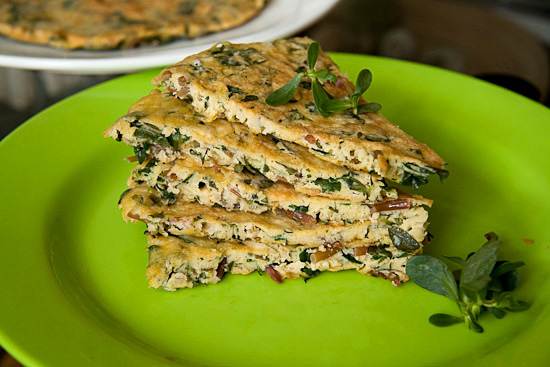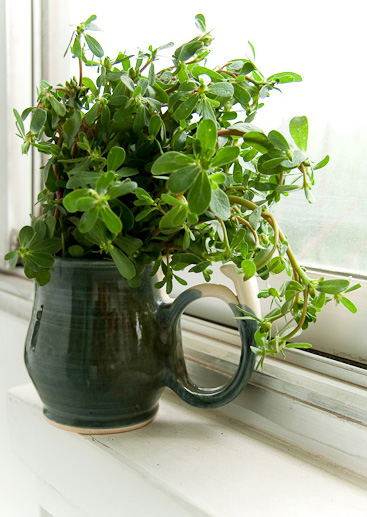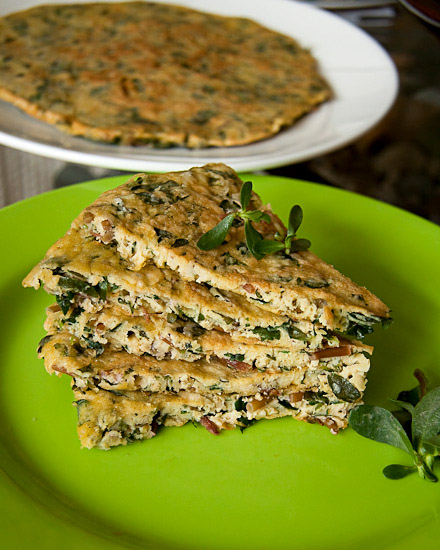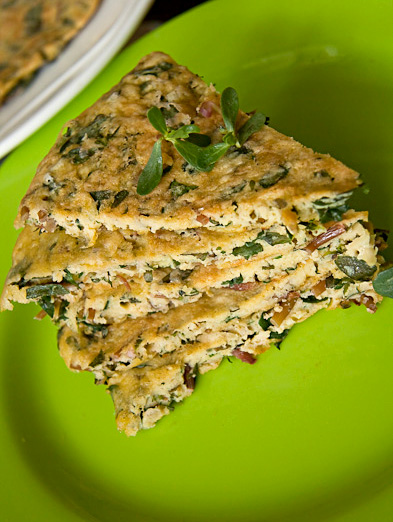I can clearly remember the first time I ate purslane. I was eight, and the ayi who worked for my family had brought back a bag of purslane from her home province in southern China. She made them into golden crisp purslane bing (饼), or pancakes, and I was instantly smitten: It was somehow decadent, as pancakes were a rare treat, but also very healthful from the succulent crunch of the purslane.
Indeed, purslane is about one of the most healthful vegetables that one can eat. It has more omega-3 fatty acids than any other plants, and a whole lot of other anti-oxidants and anti-mutagenic nutrients, minerals, and vitamins. Apparently, it was also Gandhi’s favorite vegetable, according to this informative article. In Chinese, it’s considered a wild vegetable (yecai 野菜), called machixian 马齿苋, or “horse teeth amaranth” – perhaps because the little leaves look like horses’ teeth?
Despite all its benefits, purslane has long been thought of as a weed in the US, and only now have people started eating it. In China, of course, we’ve known we can eat purslane for a while, but Beijing is not the best place to find something that needs green fields and wild spaces. (And even if you were to find wild vegetables growing by the road in Beijing, would you eat it?)
So remarkably, I hadn’t eaten purslane for more than 17 years. That one-time experience had made such an impression on me, though, that as soon as it was available from my organic farm supplier, I knew I had to get it. Since then, I’ve had plenty of opportunities to play with purslane: in salads with a vinegar-soy sauce dressing and thousand-year-eggs muddled in, stir-fried with peppers, and slowly simmered in a multi-grain rice congee.
But of course, I had to go back to the pancakes that made me fall in love with purslane in the first place. The Internet was not forthcoming with recipes or advice, only informing me that this was a traditional way of eating purslane in the countryside. So I recreated them using an eight-year-old’s memory – and I must say, I have quite a good memory.
Purslane Pancakes
Serves 2 as a main dish, or 4-6 as a side dish.
250g purslane (a little over a half pound)
2 cups flour
3 (small) eggs, beaten
1-1½ cups water
1 tsp baking soda
salt (around 1/2 tsp)
pepperWash the purslane, and chop it up into approximately ¾-inch/2cm segments. Combine the flour, eggs, and water. Mix in the purslane (a handful of chopped scallions would be good too, but I didn’t have any), baking soda, salt, and pepper. Add a little more water if the batter doesn’t seem liquid enough – you want it to flow easily on the griddle.
Heat a frying pan or a griddle to medium-low heat. Add a splash of oil, and ladle enough batter into the pan as to cover the entire cooking surface; you don’t want these to be too thick or too thin. Cook on one-side until the center bubbles and the bottom is golden, then flip and cook on the other side.
Serving
Slice the pancakes pizza style. They’re tasty on their own, but even more delicious when dipped into a simple dipping sauce.Dipping sauce
For each person, combine soy sauce and vinegar (you want more vinegar than soy sauce, perhaps at the ratio of 1:2), 1-2 cloves minced garlic, and optional chili sauce or chili powder. This is the same sauce used for hutazi 糊塌子, traditional Beijing carrot-and-zucchini pancakes.









































I was JUST wondering what purslane was!! It’s like you read my mind. Now I’ll go out there and find some cause I’m dying of curiousity